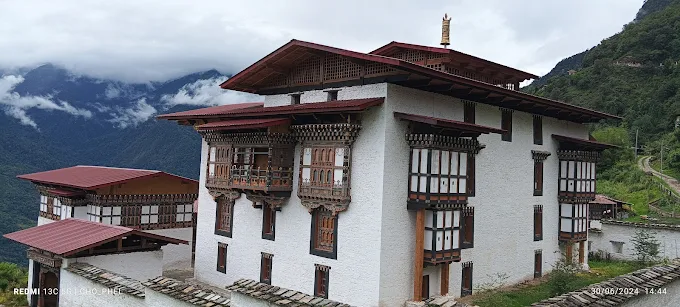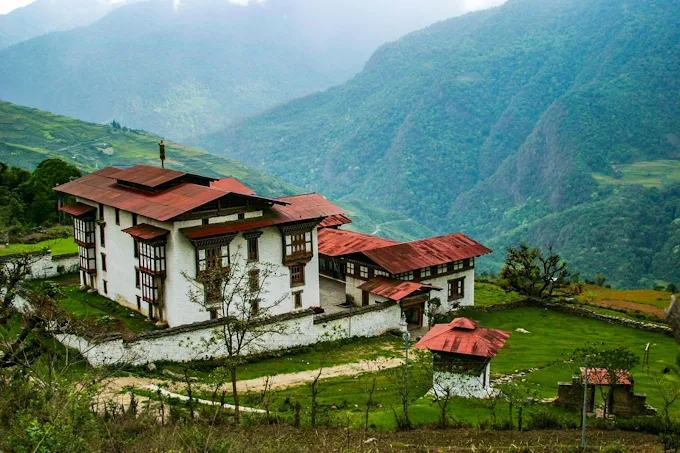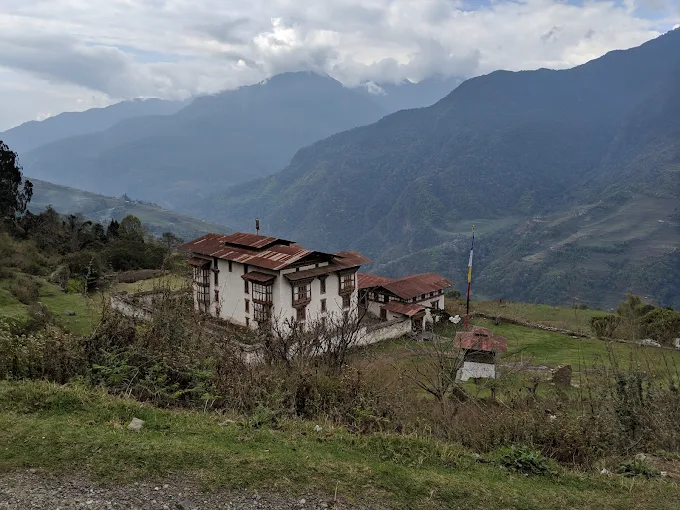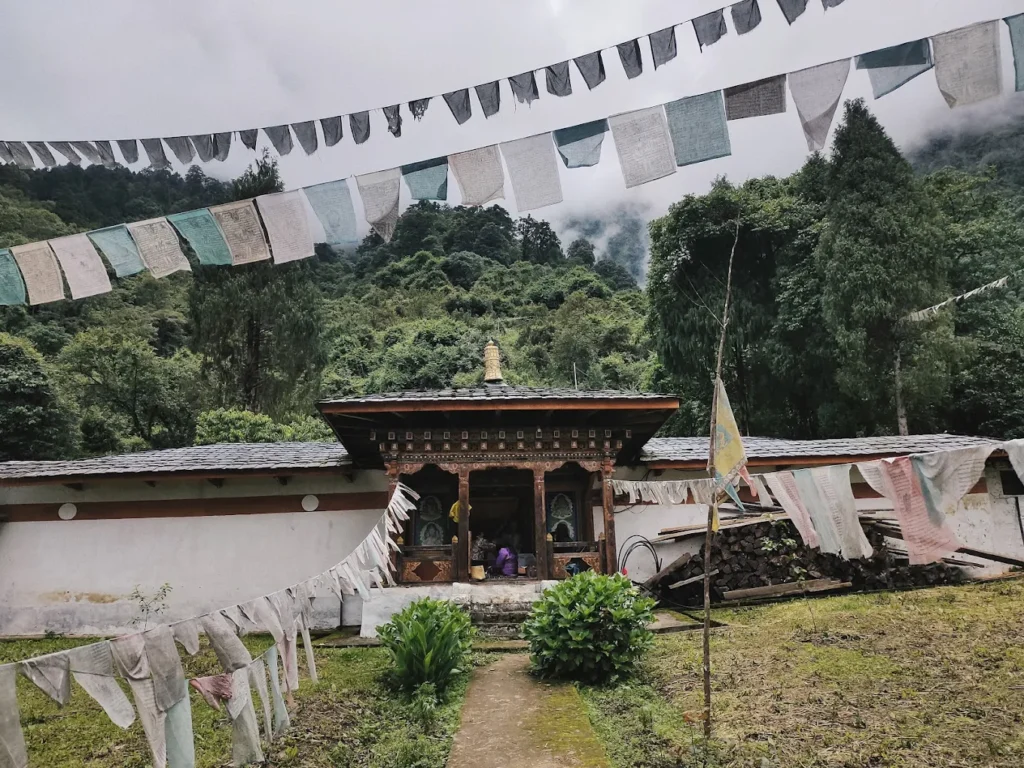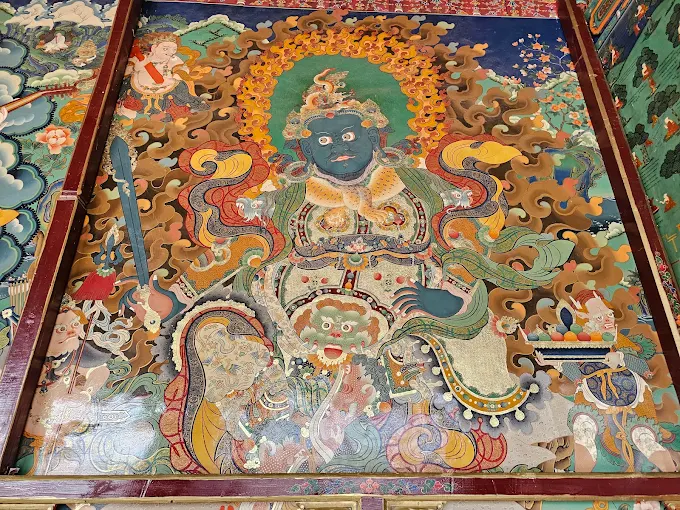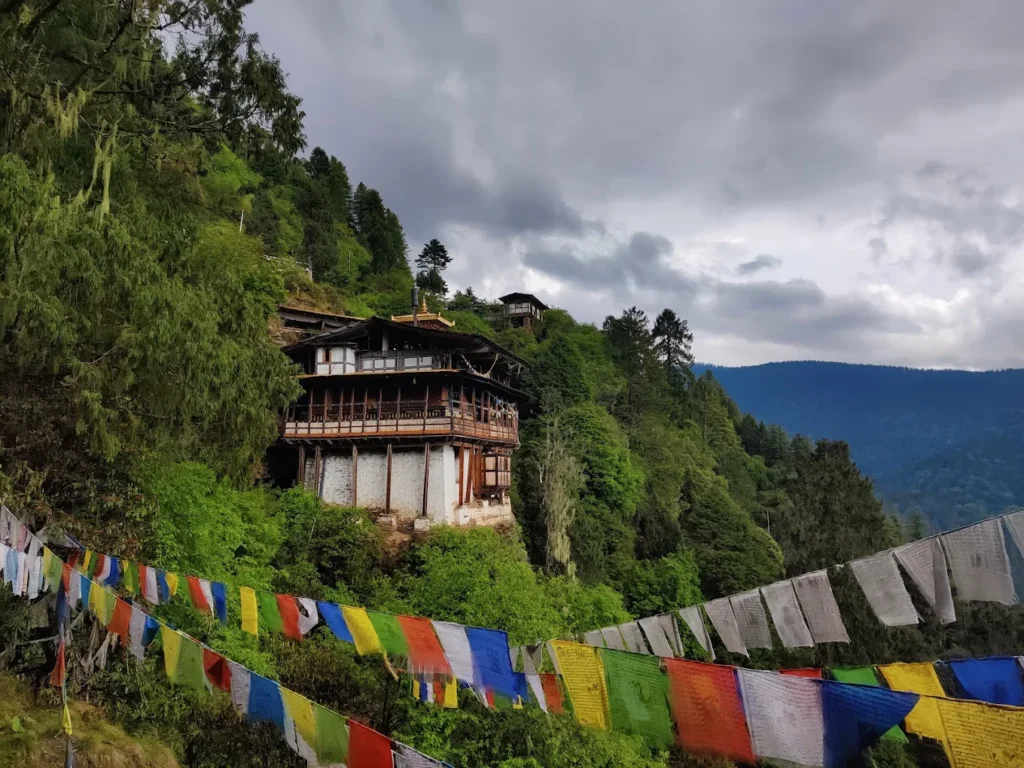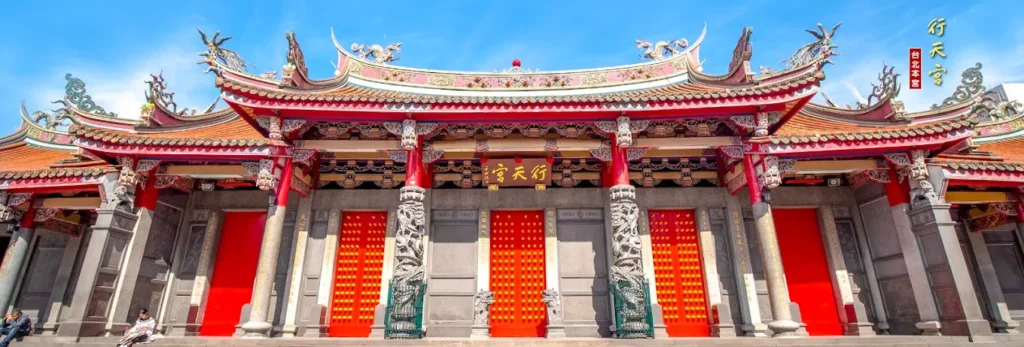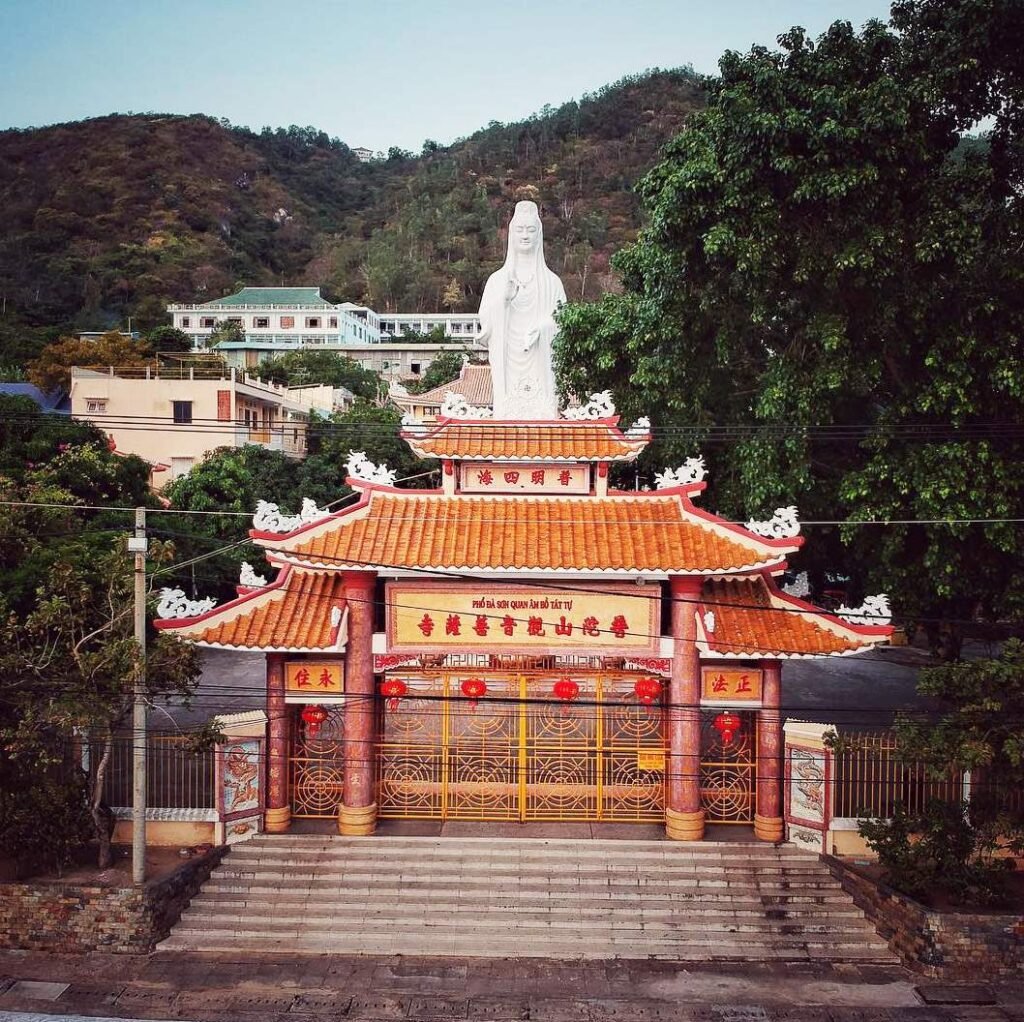Kuenga Rabten Shedra: Beacon of Bhutan’s Nuns’ Scholarship in Trongsa’s Hills
As dawn breaks over Trongsa’s rugged slopes, Kuenga Rabten Shedra stirs atop a hillside, its whitewashed temple catching the first light above Kuenga Rabten village. Within, nuns chant the Lotus Sutra, their voices weaving through a shrine where a bronze Guru Rinpoche (Padmasambhava) gazes, flanked by Shakyamuni Buddha and Tara’s serene form. In the classroom, texts of Madhyamaka philosophy lie open, marking this shedra as Bhutan’s first monastic college for nuns, founded in 2011. During Vesak, butter lamps flicker in the courtyard, honoring Buddha’s enlightenment as nuns lead prayers. Established by Khenpo Tshultrim Jamtsho within Karma Drubdey Nunnery in 1972, this Karma Kagyu (Karma Bka’ brgyud) sanctuary, perched 24 km from Trongsa Dzong, empowers women in Buddhist scholarship. Amid Bhutan’s misty valleys, it blends study, ritual, and resilience, inviting seekers to a haven where wisdom thrives.
Overview and Significance
Kuenga Rabten Shedra, nestled above Kuenga Rabten village in Trongsa, stands as a pioneering Karma Kagyu institution, its 2011 founding marking a milestone for Bhutanese nuns’ education. This college weaves scholarship, devotion, and community, shaping Bhutan’s spiritual landscape.
Introduction to Kuenga Rabten Shedra
Kuenga Rabten Shedra, or Shedrub Pheljeling Buddhist College for Nuns, rises on a steep hillside in Trongsa, part of Karma Drubdey Palmo Chokyi Dingkhang Nunnery. Karma Kagyu, a lineage of Tibetan Buddhism, emphasizes meditation and oral transmission from Marpa to Milarepa, guiding practitioners to enlightenment. Founded in 2011 by Khenpo Tshultrim Jamtsho, the shedra became Bhutan’s first academic institution for nuns, with its first graduates in 2021. Its classrooms, alive with philosophical debate, anchor a site where study and ritual converge, offering a window into Bhutan’s evolving Buddhist tradition.
Historical Journey
The shedra’s story unfolds within the nunnery’s legacy:
- Nunnery Founding (1972): Khenpo Tshultrim Jamtsho, a Tibetan refugee, established the nunnery above Kuenga Rabten, blessed by Queen Ashi Phuntsho Choden.
- Shedra Inception (2011): The shedra opened, offering nuns formal Buddhist studies.
- First Graduates (2021): Thirty-five nuns completed a decade-long curriculum, a historic achievement.
- Relocation Plans: Geological instability prompts plans to move the main nunnery to Samcholing, 8 km away, with the shedra’s future under review.
Cultural Significance
The shedra reshapes Bhutan’s spiritual fabric:
- Educational Pioneer: It empowers nuns as scholars, challenging gender norms.
- Community Hub: Vesak and Losar unite Kuenga Rabten residents.
- Kagyu Anchor: It preserves Milarepa’s meditative lineage.
Unique Legacy
As Bhutan’s first nuns’ shedra, its 2021 graduates mark a new era of female scholarship.
Community and Global Impact
- Local Role: Educates 35 nuns alongside local school students.
- Diaspora Ties: Attracts Kagyu practitioners globally.
- International Note: Its pioneering model inspires Buddhist education.
Historical Anecdotes
- Khenpo Tshultrim meditated in a cave where the temple now stands, guided by a vision.
- In 2021, graduates’ debates drew Trongsa’s monastic leaders, a rare honor.
Social Role
Study retreats and charity knit community bonds.
Artistic Influence
Temple murals inspire local thangka painters.
The shedra’s history shapes its form, where temple and classrooms frame a space of learning and faith.
Architectural and Spiritual Features
Kuenga Rabten Shedra’s modest temple and classrooms blend Kagyu simplicity with Bhutanese craft, perched above Trongsa’s valleys. This section explores its design and sacred spaces.
Iconic Design
The shedra’s whitewashed temple, with wooden beams and a sloped roof, crowns a hillside. A courtyard of packed earth, fringed by prayer flags, overlooks Kuenga Rabten’s fields.
Key Structures
- Main Temple (Lhakhang): A single-story hall with hand-painted murals and altars.
- Shedra Classrooms: A 2011 building with wooden desks for 35 nuns.
- Nuns’ Hostel: A 2017 structure housing 180 nuns.
- Retreat Center (Drubdey): A quiet wing for meditation.
Worshipped Statues/Deities
- Guru Rinpoche: A bronze statue honors Kagyu’s founder.
- Shakyamuni Buddha: A central icon depicts enlightenment.
- Tara: A statue embodies compassion.
Materials and Techniques
Timber frames and stone walls, with murals in mineral pigments, reflect Bhutanese artistry.
Signature Elements
The temple’s murals and classroom texts define the shedra’s scholarly heart.
Lesser-Known Features
- Cave Relic: Khenpo Tshultrim’s meditation cave lies beneath the temple.
- Prayer Wheels: Line the courtyard’s edge, spun by nuns.
Preservation Efforts
Since 2016, repairs counter hillside cracks, pending relocation.
Environmental Integration
The hillside perch and nearby stream tie the shedra to Trongsa’s landscape.
Artisan Narratives
Trongsa painters restored murals, using 8th-century techniques.
Symbolic Details
Tara’s green hue signifies compassion; lotus motifs evoke purity.
Landscape Integration
The shedra’s vantage offers valley views, enhancing meditative calm.
These spaces cradle the shedra’s rituals, drawing nuns into Kagyu’s meditative pulse.
Rituals and Practices
Kuenga Rabten Shedra’s rituals, rooted in Karma Kagyu, blend study and devotion, fostering enlightenment. This section explores its ceremonial life.
Daily Sacred Rites
- Sutra Chanting: Nuns recite Kagyu texts at dawn.
- Offerings: Butter lamps honor Tara and Guru Rinpoche.
- Meditation: Sessions focus on Mahamudra practice.
Unique Practices
Nuns debate Madhyamaka texts weekly, a scholarly ritual honed in the shedra.
Festival Traditions
- Vesak: Butter lamps and prayers mark Buddha’s life in May.
- Losar: New Year rites in February include prosperity chants.
Visitor Engagement
Guests may observe debates or join Vesak prayers, guided by nuns.
Spiritual Community Roles
Nuns lead rites; locals support festivals, fostering unity.
Interfaith Connections
Exchanges with Nyingma monks reflect Bhutanese harmony.
Ritual Symbolism
- Butter Lamps: Light signifies wisdom.
- Prayer Wheels: Spins carry prayers skyward.
Seasonal Variations
Losar adds festive chants; monsoon retreats deepen meditation.
Monastic/Community Life
Nuns study texts; locals tend the courtyard.
These rituals guide visitors to the shedra’s philosophical depths.
Visitor Information
Kuenga Rabten Shedra welcomes travelers to Trongsa’s hills, offering practical details to engage with its scholarly heart.
Navigating to Kuenga Rabten Shedra
Above Kuenga Rabten village, a 30-minute walk from the Trongsa-Zhemgang highway, the shedra’s temple is marked by prayer flags, 24 km from Trongsa Dzong.
Address of Kuenga Rabten Shedra
Kuenga Rabten, Trongsa County, Bhutan
Visiting Hours and Etiquette
- Hours: Open daily from 7:00 AM to 5:00 PM, extended during Vesak.
- Etiquette: Dress modestly; remove shoes in the temple; avoid photographing altars.
Transport Options
- Car: A 1-hour drive from Trongsa via taxi.
- Bus: Trongsa buses stop at Kuenga Rabten, then a short walk.
- Hiking: A 30-minute ascent from the highway.
Accessibility and Safety
- Accessibility: The courtyard is flat; steps limit temple access.
- Safety: Trongsa is safe, but carry water for the walk.
Amenities and Surroundings
Restrooms and tea stalls are in Kuenga Rabten village.
Immersive Tips
Visit in May for Vesak or observe weekly debates.
Nearby Cultural Experiences
- Kuenga Rabten Palace: 1 km away, a historic monastery.
- Trongsa Dzong: 24 km away, a fortress landmark.
Photography Tips
Capture the temple at sunrise; respect altar restrictions.
The shedra’s gates open to its Kagyu philosophy, where scholarship and faith unfold.
Cultural and Spiritual Insights
Kuenga Rabten Shedra’s essence lies in its pioneering role and Kagyu roots, offering insights into Bhutan’s spiritual depth.
Religious Philosophy
Karma Kagyu teaches enlightenment through Mahamudra meditation, guiding nuns to wisdom.
Environmental Spirituality
The hillside stream reflects nature’s sanctity, a Kagyu value.
Artistic Symbolism
Tara’s statue embodies compassion; lotus motifs signify purity.
Community Resilience
In 2011, nuns embraced scholarship, redefining roles.
Environmental Stewardship
Nuns plant trees, honoring Bhutan’s eco-ethos.
Meditative Practices
Mahamudra sessions cultivate clarity, open to visitors.
Cultural Narratives
Khenpo Tshultrim’s cave vision inspires local tales.
Historical Context
The shedra ties to Bhutan’s 20th-century Kagyu revival.
These insights weave a reflection on the shedra’s enduring presence.
Conclusion
Kuenga Rabten Shedra shines as a beacon of Bhutan’s Buddhist scholarship, its 2011 founding empowering nuns to carry Karma Kagyu’s torch. Guru Rinpoche’s bronze gaze and Vesak’s butter lamps weave wisdom into Trongsa’s hills. From classroom debates to courtyard prayers, it fosters enlightenment amid Bhutan’s valleys. As a trailblazer, it bridges tradition and progress, inviting travelers to pause where nuns’ chants echo Milarepa’s legacy, a testament to enduring faith.
